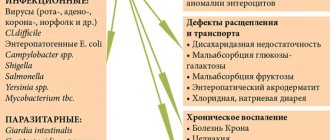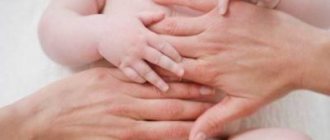Often, foam in a child’s stool is nothing more than increased gas formation. Most often, this symptom appears in infants, since their digestive system is not yet completely perfect.
In older children, foaming that began suddenly indicates a malfunction of the gastrointestinal tract. Parents should observe the color of the discharge, its frequency, impurities in the stool and the presence of additional symptoms in the baby.
If foam in the stool is accompanied by a high temperature, and the child looks sick, you should show him to your local pediatrician or call an ambulance.
What is it and should you worry?
Normally, an infant's stool is a pasty consistency of yellow and brown shades. When foam appears in it, this indicates that the fermentation process has begun in the intestines. Attentive parents immediately notice the child's foamy stool and begin to worry.
In fact, this phenomenon is not always a sign of pathology of the digestive system. When the child was in the womb, the digestive system in his body was just forming; he received the main nutrients from his mother. After the birth of the baby and the start of breastfeeding (BF), she just begins to work fully.
As digestive processes develop, which usually return to normal by 3 months of age, stool may change.
Stool characteristics may change over the first few years of life. If at the same time the newborn does not have deterioration in condition, pain, he feels normal and is cheerful, there is no reason for concern. But if other symptoms of digestive system diseases occur with foamy stools, you need to find out the reasons and consult a doctor.
Cause for concern also arises when foamy stool occurs at an older age. If at 1-2 months this may be normal, then at 3-4 years it is not. Problems with feces can also arise at about 1 year of age, if before that the child was breastfed, and now other foods are introduced into the diet.
Food allergies
Food allergies occur when new foods are introduced into complementary foods.
An allergic reaction may appear as foamy stools. The most common provocateurs of allergic reactions in infancy are:
- For products received by the mother (citrus fruits, berries, nuts).
- For newly introduced mixtures.
- On medications, especially when using antibacterial drugs.
- For certain types of complementary foods or when they are introduced too early.
As soon as allergens can be identified and eliminated, the stool will become normal.
Reasons related to maternal and child nutrition
If foamy stool is not normal, as evidenced by a deterioration in the child’s general condition and other signs, you need to pay attention to nutrition. Many reasons for such feces lie in the wrong choice of foods for feeding the baby and mother. In such cases, in order to normalize stool, it is enough to streamline your diet, avoiding junk food.
The main reasons related to the nutrition of mother and child are:
- Adding a new product to the diet. The stool may be either foamy or foamy and with mucus. You can try to remove the product and then introduce it into the diet after a while, but not earlier than after a month.
- Introducing complementary foods too early. Some mothers feel that the baby is not getting enough of her milk, and they immediately introduce additional foods into his diet. It is better to abstain from complementary foods until the age of six months, and if there is really little milk, then coordinate the choice of products with your doctor.
- Feeding errors. If a child constantly drinks only foremilk and does not get to the hindmilk, he misses out on many useful substances.
- With artificial nutrition. For a number of reasons, some mothers are unable to breastfeed their infants. Finding the right nutrition takes time. If the body does not accept the chosen product, it will give signals, one of which is foamy stool with a strong odor.
- Taking medications. Some medications taken by both mother and child contribute to the development of side effects that affect the digestive system. Loose stools with foam may be one of them.
- Errors in maternal nutrition. When breastfeeding, it is important for a woman to adhere to a diet and avoid prohibited foods. Violation of these rules can lead to problems with the formation of feces in the baby.
It is necessary to introduce new foods into the diet one at a time in order to understand which of them the body cannot yet process normally.
When to see a doctor
Parents are required to consult a doctor about all changes that occur in the child’s body. If the baby does not show signs of anxiety, and the symptoms are limited to gases in the stool, you can postpone the issue until your next visit to the pediatrician. However, in some cases it is not worth delaying contacting a specialist.
What symptoms pose a danger to the baby’s health:
- temperature rise to high levels;
- the presence of mucus or blood in the stool;
- the stool is accompanied by a pungent odor;
- lethargy, weakness and excessive drowsiness in infants;
- refusal to eat;
- sleep disturbance;
- the child bends his legs to his stomach and screams;
- numerous regurgitations of more than a tablespoon at a time (this can be considered vomiting).
If one or more symptoms are observed, it is better not to risk it and show the child to a competent specialist. The quality and duration of further treatment depends on timely seeking help.
Other causative factors
Some causes of foamy stools are associated with serious pathologies and diseases of the digestive system. To understand that abnormalities in stool are not just an age-related norm, you need to pay attention to the accompanying symptoms.
The main causes are the following diseases:
- Intestinal dysfunction. This condition may be associated with several gastrointestinal diseases, such as dysbiosis, flatulence, and enzyme deficiency. Dysbacteriosis occurs most often in infants; it is associated with changes in microflora, which result in a deficiency of beneficial bacteria. Special treatment is usually not required; taking probiotics and adjusting your diet is enough.
- Intestinal infection. A dangerous condition that requires immediate medical attention. The infection can enter the intestines both with food and through infection from other organs. The main danger is associated with the risk of intestinal dehydration. Associated conditions are lethargy, weakness, nausea, vomiting, and stomach pain.
- Staphylococcus aureus. These bacteria are always present in the human body, but when their number increases due to various factors, problems arise. Due to its intense increase, immunity decreases, complications also affect the digestive system.
- Lactose intolerance or deficiency. Lactose is an important component of breast milk, which gives this product a lot of beneficial properties. Most of this substance is found in hind milk, and if the child does not receive enough of it, problems with feces arise.
The above causes of foamy stool can occur not only in newborns, but also in older children aged 4-5 years and older.
Symptomatic therapy
For mild forms of defecation disorders, non-drug methods are recommended: drinking plenty of fluids to replenish water balance, eliminating fatty and spicy foods, baked goods and fast food from the diet. To eliminate increased gas formation, enterosorbents can be used. Do not take strong antidiarrheal medications without a doctor's prescription because they may cause side effects. If the discharge of liquid, foul-smelling stool continues for more than 2-3 days, you should consult a specialist.
Probiotics are prescribed to prevent antibiotic-associated diarrhea. The presence of other dyspeptic symptoms (severe cramping abdominal pain, repeated vomiting, blood in the stool) against the background of foamy diarrhea is an indication for seeking medical help. Attempts to independently treat such conditions are fraught with the development of severe dehydration and aggravation of the underlying disease. Etiotropic and pathogenetic therapy is prescribed by a gastroenterologist after identifying the causes of stool disorders.
Diagnosis by stool color
By the way the stool looks, you can determine the possible cause of the deviation. Disturbances in the functioning of the gastrointestinal tract affect the process of fecal formation, so stool can change its color. Parents often find stools of these shades:
Baby's green stool
- Light. Most often it is a sign of dysbiosis, in which an excessive number of pathogenic bacteria are present in the intestines. And also light-colored foamy stools may be a sign that there is a bile deficiency. Poor outflow of this substance is a symptom of several diseases, so an ultrasound of all abdominal organs is required.
- Green. This type of stool is often called “hungry” - it is a sign that the child is not getting enough nutrients from food. If he has reached six months of age, this may be a sign of the need for complementary feeding. In other cases, dark green stool may be a symptom of an intestinal infection or staph.
- Yellow. Often this shade is normal, but over time it should fade to brown. If this does not happen or other problems appear, such as insufficient weight gain, abdominal pain, or deterioration in health, you should contact your pediatrician. Sometimes yellow, foamy stool indicates problems in the intestinal microflora.
- With red veins. Indicates lactose intolerance. Mom needs to reconsider her diet, reduce the amount of dairy products consumed. Less commonly, red streaks indicate intestinal dysfunction.
- White. It is rare and is a symptom of poor bile flow. In severe cases, foamy stools become white due to impurities of pus. Then urgent hospitalization and identification of the cause are required.
Survey
When foamy stools appear, patients consult a gastroenterologist. Since the symptom can be due to various reasons, the specialist prescribes a comprehensive examination of the gastrointestinal tract using instrumental and laboratory methods. A diagnostic search involves clarifying the cause of defecation disorders and assessing the degree of secondary disturbance of metabolic processes in the body. The most valuable ones are:
- Coprogram
. During a standard stool analysis, its consistency is assessed and undigested food particles are detected. The pH of foamy stool must be measured and the levels of individual enzymes determined, which is important for the timely diagnosis of enzyme deficiency. - Bacteriological analysis
. To verify intestinal dysbiosis, it is necessary to inoculate stool on nutrient media with identification of all bacterial colonies. More informative is the culture of the contents of the small intestine, which is obtained using a probe. - Functional tests
. To quickly and non-invasively detect lactase deficiency, a special breath test is used. An increase in the level of hydrogen in the exhaled air after ingesting large amounts of milk sugar indicates a primary enzyme deficiency. - Ultrasonography
. Abdominal ultrasound is used as a screening to identify structural changes in the gastrointestinal tract, which may indicate the presence of organic pathology. Sonography is widely prescribed in childhood because the method is absolutely safe and painless. - Radiography
. Serial radiographs after oral contrast with barium sulfate are recommended for persistent bowel abnormalities. On radiographs, the contours of intestinal loops, the presence of defects in the intestinal wall, and space-occupying formations are assessed.
All patients are shown general and biochemical blood tests. To clarify the diagnosis of gluten enteropathy, an endoscopic examination of the duodenum with a biopsy of its walls is performed. Confirmation of intestinal infections is performed by detecting antibodies in blood plasma. If you suspect a connection between foamy stools and congenital diseases, consultation with a specialist in the field of medical genetics is recommended.
Bacteriological analysis of stool
Photo
The photo below shows the main colors of stool, which are most common in young children and indicate problems in the gastrointestinal tract: yellow, green, with red streaks.
Yellow foamy stool.
Green foamy stool.
Foamy stool with red streaks.
Staphylococcal infection in the intestines
This is a serious damage to the body. Foamy stools may be one of the symptoms of this serious disease. In addition to this, indigestion, watery, mucous stools, and pain should alert you.
The presence of infection is determined by stool analysis. If the assumption is confirmed, they must undergo comprehensive treatment. After all, the consequences of such an infection can be unpredictable.
Watch the video about constipation in infants:
https://www.youtube.com/watch?v=J2Mb7IeGPW4
What should parents do?
The actions of parents depend on the reason why the child has a problem. Even if he feels great, and there are no symptoms of deterioration, and you think that such feces are normal, it is better to consult a doctor. First, you need to go to a pediatrician; if necessary, he will give you a referral for an ultrasound of the abdominal organs or other diagnostics. If there are no deviations, the pediatrician can give recommendations on adjusting the diet for the mother and baby.
Attention! It is impossible to independently give your baby any medications aimed at normalizing the functioning of the gastrointestinal tract without an established cause for foamy stools.
If your baby has been diagnosed with dysbiosis, you will need to use drugs like Bifiform to restore the intestinal microflora. If lactose deficiency is detected, the mother needs to express her foremilk, feed her baby her hindmilk, and may also need to take certain medications.
One of the most serious diseases that can be detected with foamy stools is an intestinal infection. Urgent hospitalization is usually required, and therapy is prescribed to prevent dehydration and eliminate symptoms of infection.
Thus, foamy stool in infants may be normal, indicating that the digestive system is improving its functioning. Cause for concern arises when other symptoms of deterioration in the child’s condition appear or the problem does not go away with age. To determine the cause, you must contact your pediatrician, then follow his instructions regarding treatment.
Prevention
Prevention of gastrointestinal diseases includes correcting the nutrition of a nursing mother and baby. You should contact a gastroenterologist to help you choose the most appropriate menu for your particular case.
It is recommended to regularly treat all objects that the baby comes into contact with. Pacifiers, pacifiers and toys should be washed in hot water and unscented soap. A nursing mother should regularly perform breast hygiene, but you should not overdo it with treatment either, since constant washing of the mammary glands will cause dry skin and the appearance of cracks in the nipples.
If you follow all medical recommendations and carefully monitor the condition of the child’s body, many problems can be prevented or eliminated in the early stages of development.
Fermentative dyspepsia
This condition is typical for older children. External manifestations of this pathology:
- small amounts of foamy stool;
- bloating;
- rumbling, unpleasant sensations.
The main cause of this condition is an unbalanced diet. Children eat a lot of fruit, drink kvass and carbonated drinks in abundance. Fermentation dyspepsia can be triggered by legumes and cabbage.
If the condition is not yet advanced, the situation will return to normal quickly without outside intervention. If signs of fermentative dyspepsia have been bothering you for more than one day, you need to follow a diet that excludes carbohydrates. The diet should be very strict for 4 days.
Only meat and fish are allowed; cottage cheese is used as a supplement. Carbohydrates are introduced gradually and observed how the body reacts to their appearance. Usually everything goes back to normal, no complications arise.
Use of drugs
Sometimes a child does not have accompanying symptoms of the disease, so only medications are required to eliminate diarrhea.
The most effective medications for children:
- Imodium has a pronounced antidiarrheal effect, but it is allowed to be used only in the treatment of patients over 6 years of age. Capsules are taken orally, 1 piece no more than 2 times a day. The medication helps to quickly eliminate the manifestation and prevents excessive fluid loss due to frequent loose stools. The duration of use of the medication usually does not exceed 2 days.
- Lopedium is also considered an effective remedy against diarrhea. It is prescribed in short courses of 1-3 days with daily intake of 1 to 3 tablets of the medicine. The medication is indicated for patients over 6 years of age, but in some cases the doctor may prescribe it to a child under 6 years of age based on individual indications.
If loose stools do not occur many times during the day, special medications may not be prescribed. In this case, the child’s diet is changed, some foods are excluded and the amount of liquid consumed during the day is increased. In each case, an individual approach to each child is required.











